Hello, and welcome back to RENDERED. Happy Halloween to all! This post is for everyone, so feel free to share it. I'm back from a restful few weeks with my family. In the meantime, I put some compilation videos, including a sketchbook tour, on my Youtube channel. My Etsy shop is also now back in action!
If you're hungry for more content in audio format, consider a paid subscription. For 5€, you can get a month's worth of access to my narrated essay series, TIDBITS. Yearly subscribers get a RENDERED logo sticker, and Art Collectors receive a custom painting.
RENDERED is a one-woman production, and your support is appreciated! Now without further ado, let's get into it.
I've got a lot of love for mushrooms. I grew up eating those (admittedly less exciting) white button mushrooms on my pizza, perhaps scattered into a salad, but it wasn't until I spent time in Asia, where I discovered more intriguing possibilities: jelly-like wood ear mushrooms in Korean japchae; thick-cut slices of king oyster mushrooms sizzling on a cast-iron griddle alongside kimchi and pork belly at a Korean barbecue restaurant; enoki and shimeji mushrooms cooked into tender lusciousness in Japanese sukiyaki... and don't even get me started on the morels, cepes, and chanterelles I can get my hands on here in France!
There is a mountain of folklore and oral traditions involving edible mushrooms, like:
- the northern Japanese tale of the shimeji ghosts (Obake shimeji) that came to life at night in droves (Check out this cute Japanese animation of the story of Obake Shimeji, or Ghost Shimeji, on Youtube)
- Tsimshian stories of "Ears of Ghosts" (Exobasidium vaccinii), an edible fungus that signals a frightful child-snatching creature has been lurking around (in a Pacific Northwest coastal Indigenous tradition)
- an Italian folktale of a witch who disguises herself as a mushroom to catch a cabbage thief in her garden
- fairy rings, or mushroom circles that appear in grassy areas--a sign that there is some kind of magic afoot: elves, fairies, or even dragons. Depending on who you ask, fairy rings are portents of either good or bad luck!
The world of mushrooms is vast, storied, and visually stunning. But today, for this essay, I wanted to think about mycelium's Bad Boys: toadstools. Those forbidden fungi, sprouting up in backyards, forests, and through sidewalk cracks after an autumn rain. Prudence reminds me to keep a safe distance, but Curiosity wonders why squirrels can eat them, but I can't.
From the alluring red-capped Amanita muscaria to fairy rings, witches like the Baba Yaga, and magical concoctions, toadstools have an aura of danger and mystery, steeped in folkloric charm.
What distinguishes a toadstool from a plain ol' run-of-the-mill mushroom? As far as I've read, a toadstool is a toxic or inedible mushroom. Toadstools might just taste gross--they could also give you a psychotropic experience, cause tummy troubles, or shut down your organs and kill you.
The name "toadstool" in English certainly has an ominous forewarning to it. I wouldn't want to gobble up a mushroom that some warty toad has rubbed its booty on. It's a catch-all term for inedible mushrooms, but there is also a pejorative sense to it.
The word "toadstool" itself doesn't have an exact translation in other languages I'm familiar with: French calls toadstools champignon vénéneux (poisonous mushroom), in Spanish seta venenosa, kinoko and beoseot in Japanese and Korean respectively (both the same word as "mushroom"). I would love to have some champignons, setas, kinoko, or beoseot on my dinner plate. Toadstools, though? Nah.
Aside from English, there are other languages that make a distinction between "mushrooms" and "toadstools," to give us fair warning:
- In Norwegian and Danish, they're "toad's hats"
- Dutch speaks of "toad's stools"
- Frisian calls them "toad's hide"
- In Irish, they are "frog's pouches"
- In Welsh: "toad's cheese"
- And in Breton, they're "toad's caps" or "toad's stools"
Bretons left Britain and arrived in Breizh (Brittany, northwest France) during the 5th and 6th centuries CE, meaning the origin of this phraseology may extend quite far back (though this is only a guess on my part).
The Spanish language may also have had an equivalent to "toadstool." An archaeologist working in Guatemala in the mid-1900's found that some called inedible mushrooms "sombrilla de sapo," or toad's parasol--perhaps a remnant of 16th-century Spanish?
Basque uses the word "toad" in several names for wild mushroom species, along with Ukranian and Slovakian. And in 16th century French, wild mushrooms were called pain de crapault--"toad's bread."
But why the "toad" in "toadstool"? Toads in nature don't have any relationship to mushrooms--they neither take up shelter underneath them, nor place their butts upon them. It may be because toads are actually poisonous--they secrete a toxic substance. This bufotoxin can kill small animals (keep your pets away from them!), or cause a burning discomfort for humans if it should make its way to any mucous membranes (like eyes, mouth...)
Etymology isn't always an exact science, and unproven theories remain... the word "toad" might have come from tosca, or toxicum: poison.
Whether or not this is true, toads--like toadstools--have garnered an icky reputation. The medieval world regarded them as fearsome things, poisonous, and even (like warts) a symbol of lechery. No wonder witches keep them as familiars! According to folklore, that is. And the Inquisition.
Fun fact: In Dutch, a stye in the eye is called paddescheet, or "toad's excrement."
If any readers have input on "toadstool" in other languages, please let me know in the comments!

To any mushroom foragers reading this: respect! You've got a bead on the hidden secrets of your local environment, and it takes a lot of skill to distinguish the yummies from the no-no's. To anyone who isn't a mushroom forager: I'm sure I'm not the first person to tell you, but for safety's sake, NEVER PICK A WILD MUSHROOM that you haven't identified with 100% certainty!
Fun fact: if you're in France, you can apparently take your unidentified mushrooms to a pharmacy for advice and identification. Pharmacists are required to take 50 hours of mycology studies as part of their certification, and are trained to assist amateur mycophiles to avoid unintentional poisoning. Veterinarians are also trained in this subject, in case your sick woofie has eaten any suspicious shrooms! (See this article in French / Voici cet article en français)
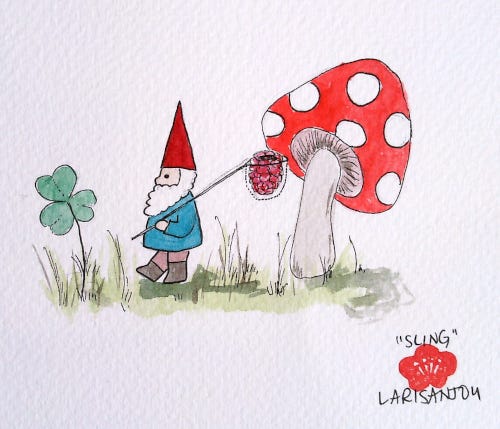
Studying the connection between humans and fungi falls under the subject of ethnomycology. Humans all over the planet have a long history of collecting, ingesting (for both gustative and ritualistic or shamanic applications), and telling stories of mysterious mushrooms and fungi. Cave art from Spain to Algeria to Siberia depicts humans with mushrooms.
Few toadstools have the same symbolic power as the Amanita muscaria, a.k.a. fly agaric. It can supposedly be used to kill flies and other insects, if the caps are soaked in milk first. It is certainly toxic to humans, but not necessarily deadly. Indeed, there have been many--spiritual practitioner, scientist and amateur alike--who have consumed these mushrooms for their stupefying effect.
Another example of a toadstool with notable secondary effects is the liberty cap, also known as Psilocybe semilanceata, or commonly: magic mushrooms. The name "liberty cap" is because the mushroom cap resembles the Phrygian cap worn by freed slaves in the Roman Empire, which later became a symbol of political freedom and of the French revolutionaries of 1789.
I'll admit, I've never eaten these toadstools before, but they apparently taste terrible--the only reason one would eat them would be because they either mistook them for a tastier variety, or they're in search of a psychedelic experience.
Fun fact: The first recorded mushroom trip in Britain was in 1799, when a well-meaning Englishman collected mushrooms on his morning walk to make a breakfast stew for his family. He succeeded in dosing his entire family and sending them on a wild trip--his doctor took copious notes and published a paper about it, and the family survived just fine.
Poor toadstools! The name is heavy with negative connotation. Foul smells, phallic imagery, witches, poison... Under the "toadstool" moniker, we group together mushrooms that are inedible, hallucinogenic, and deadly. From the inocuous yucky ones, to those with therapeutic potential, to those that will take your life.
Associated with contamination, revulsion, and witchcraft, toadstools carry lots of negative historical baggage. According to documents from the Inquisition, witches kept frogs and toads as pets, and used hallucinogenic toadstools in their potions. And what is a "witch" but a woman you don't like? A witch is a woman who embodies the archenemy of a paternalistic society. Witches, toads, and toadstools have gotten a bum rap these last few centuries.
From the Renaissance onward, mushrooms and toadstools were associated with rot, poison, and dung heaps (aptly so, but still).
Considering its icky trappings, it's no wonder the metaphor of the toadstool has also been used in propaganda. From the Nazis, to anti-evolution creationists, to US-American political propaganda during the Vietnam War, the toadstool's image has been used to satirize, or downright demonize, certain groups of people.
It wasn't until people started leaving the countryside for the cities, and folklorists like the Brothers Grimm started recording their tales, that a renewed interest in pastoral life came about. Victorian England became entranced with romanticized ideas about rustic, picturesque country life. So, illustrators began depicting more elements of folkloric charm: fairies, fly agaric toadstools, lush plants and flowers. With the Amanita muscaria undergoing an image revamp in the 1800's, it brought a cuter side to the toadstool family, for a much-needed glow-up to their reputation.
I would argue that the cottagecore movement (which surged in popularity during Covid lockdowns) is an extension of this Victorian sensibility. People wanted (and still want) to imagine themselves in the peaceful quiet of a forest glen, enjoying a kind of cozy domesticity away from the pressures and constraints of our modern world. (It's also no wonder that the idyllic existence cultivated in cottagecore would gain popularity in queer subcultures.) Search for "cottagecore art" and you'll be bombarded with cute images of toadstools.
What makes a Bad Fungi is sometimes in the eye of the beholder. Corn smut, Amanita muscaria, magic mushrooms, and Penicillium roqueforti (the fungus in blue cheeze) may be distasteful to some, but Nature's precious gift to others... so who am I to yuck someone's yum?
In the names we bestow and the stories we tell, it's good to remember that they come with baggage. Unpacking it takes care and time, but I think it's worth doing.
People wiser than me have advised us to harvest Nature's gifts honorably, and to remember that biodiversity is biosecurity (Robin Wall Kimmerer and Paul Stamets, respectively... that's Stamets the mycologist, not the Starfleet officer).
Thank you for reading! If you enjoy my work and would like to support my efforts, share with a friend/hit the "like"/leave a comment to help this newsletter grow, visit my web store, or consider a paid subscription. I also accept one-time donations via my website.
To follow my art practice, catch me on Instagram or view my portfolio on my website. Be well, take care of your heart, and I'll see you all next month.
Bibliography
Dugan, Frank M. "Fungi, Folkways and Fairy Tales: Mushrooms & Mildews In Stories, Remedies & Rituals, From Oberon to the Internet." North American Fungi, v. 3, pp. 23-72. doi: 10.2509/naf2008.003.0074
Grégoire, François. "Champignons. Les pharmaciens sont-ils suffisamment formés pour conseiller les cueilleurs ?" Ouest France, 16 Oct 2022.
Hudry, Raphaël. "Champignons : pour éviter l'intoxication, le pharmacien peut vous aider." Actu, 3 Oct 2019.
Jay, Mike. "Fungi, Folklore, and Fairyland." The Public Domain Review, 7 Oct 2020.
Kaplan, Reid W. “The Sacred Mushroom in Scandinavia.” Man, vol. 10, no. 1, 1975, pp. 72–79. JSTOR, https://doi.org/10.2307/2801183.
Kimmerer, Robin Wall. "The “Honorable Harvest”: Lessons From an Indigenous Tradition of Giving Thanks." Yes! Magazine, 26 Nov 2015.
Millman, Lawrence. Fungipedia: A Brief Compendium of Mushroom Lore. Princeton University Press, 2019. p. 53-4, 63-4, 65-6, 68-9, 119-20, 138-9, 161-2, 172-3.
Mayer, Fanny Hagin. “Fauna and Flora in Japanese Folktales.” Asian Folklore Studies, vol. 40, no. 1, 1981, pp. 23–32. JSTOR, https://doi.org/10.2307/1178139.
Nechamkin, Sarah. "The Mythology of Mushrooms." Prior, 22 Sep 2022.
Nicholson, Michael S. "Some Spiritualistic uses of Mushrooms." FUNGI Volume 2:2 Special Issue—Ethnomycology 2009.
Rutter, Gordon. "Fairy Rings." Field Mycology Volume 3, Issue 2, April 2002, p. 56-60 ISSN 1468-1641. https://doi.org/10.1016/S1468-1641(10)60143-0.
"Toads." The National Wildlife Federation.
Wasson, Valentina Pavlovna and R. Gordon Wasson. Mushrooms Russia and History, Volume 1. Pantheon Books, 1957. Available online here.
Whelan, Christal. “‘Amanita Muscaria’: The Gorgeous Mushroom.” Asian Folklore Studies, vol. 53, no. 1, 1994, pp. 163–67. JSTOR, https://doi.org/10.2307/1178564.



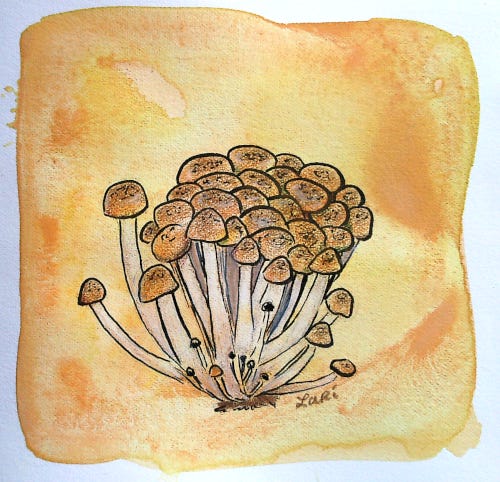
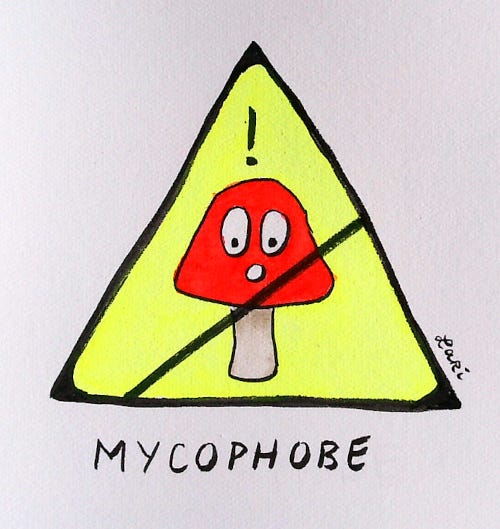
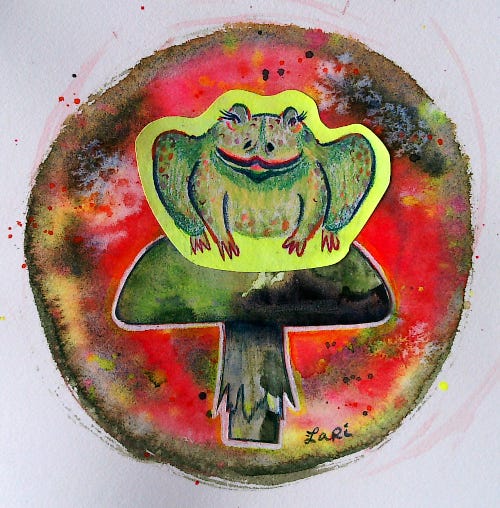


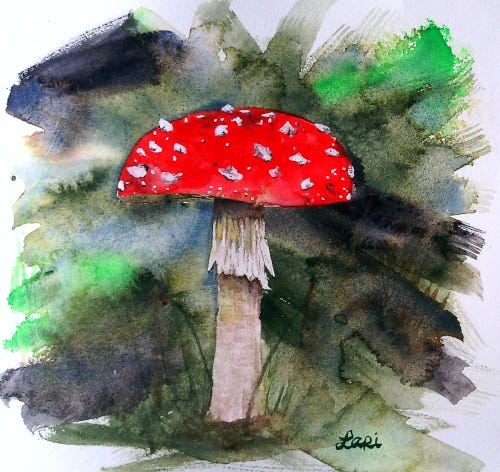
Love this issue. And want one of your watercolors! (Esp like the Amanita and the Destroying Angel prints!)